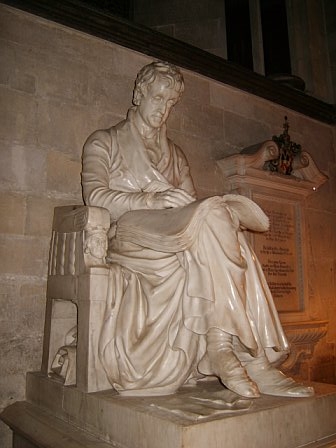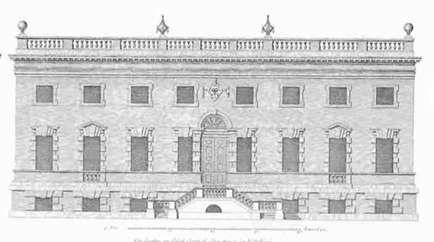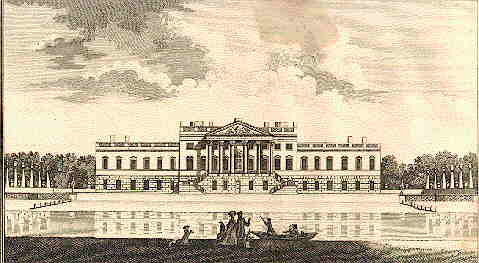|
William Benson (architect)
William Benson (1682 – 2 February 1754) was a talented amateur architect and Whig politician who sat in the House of Commons from 1715 to 1719. In 1718, he arranged to displace the aged Sir Christopher Wren as Surveyor of the King's Works, but his short time in that post was not a success. Life Benson was the eldest son of Sir William Benson, Sheriff of London in 1706–07, and his wife Martha Austin, daughter of John Austin, jeweller of London. He made a Grand Tour as a young man, which was extended to a prolonged visit in 1704–1706 to Hanover, the seat of the Elector, who was next in line to the British throne. He paid assiduous court and ingratiated himself with the Elector and his mother the Electress Sophia, pressing unwanted gifts upon the Electress. He also went to Stockholm, far from the usual beaten track. In London he published a Whig tract that offered a warning against Jacobitism, and a polemic against Divine Right of kingship in a ''Letter to Sir J cobB nkes' add ... [...More Info...] [...Related Items...] OR: [Wikipedia] [Google] [Baidu] |
British Whig Party
The Whigs were a political faction and then a political party in the Parliaments of England, Scotland, Ireland, Great Britain and the United Kingdom. Between the 1680s and the 1850s, the Whigs contested power with their rivals, the Tories. The Whigs merged into the new Liberal Party with the Peelites and Radicals in the 1850s, and other Whigs left the Liberal Party in 1886 to form the Liberal Unionist Party, which merged into the Liberals' rival, the modern day Conservative Party, in 1912. The Whigs began as a political faction that opposed absolute monarchy and Catholic Emancipation, supporting constitutional monarchism with a parliamentary system. They played a central role in the Glorious Revolution of 1688 and were the standing enemies of the Roman Catholic Stuart kings and pretenders. The period known as the Whig Supremacy (1714–1760) was enabled by the Hanoverian succession of George I in 1714 and the failure of the Jacobite rising of 1715 by Tory rebels. The Whigs ... [...More Info...] [...Related Items...] OR: [Wikipedia] [Google] [Baidu] |
Inigo Jones
Inigo Jones (; 15 July 1573 – 21 June 1652) was the first significant architect in England and Wales in the early modern period, and the first to employ Vitruvian rules of proportion and symmetry in his buildings. As the most notable architect in England and Wales, Jones was the first person to introduce the classical architecture of Rome and the Italian Renaissance to Britain. He left his mark on London by his design of single buildings, such as the Queen's House which is the first building in England designed in a pure classical style, and the Banqueting House, Whitehall, as well as the layout for Covent Garden square which became a model for future developments in the West End. He made major contributions to stage design by his work as theatrical designer for several dozen masques, most by royal command and many in collaboration with Ben Jonson. Early life and career Beyond the fact that he was born in Smithfield, London, as the son of clothworker Inigo Jones Snr., and ... [...More Info...] [...Related Items...] OR: [Wikipedia] [Google] [Baidu] |
Member Of Parliament
A member of parliament (MP) is the representative in parliament of the people who live in their electoral district. In many countries with bicameral parliaments, this term refers only to members of the lower house since upper house members often have a different title. The terms congressman/congresswoman or deputy are equivalent terms used in other jurisdictions. The term parliamentarian is also sometimes used for members of parliament, but this may also be used to refer to unelected government officials with specific roles in a parliament and other expert advisers on parliamentary procedure such as the Senate Parliamentarian in the United States. The term is also used to the characteristic of performing the duties of a member of a legislature, for example: "The two party leaders often disagreed on issues, but both were excellent parliamentarians and cooperated to get many good things done." Members of parliament typically form parliamentary groups, sometimes called caucuse ... [...More Info...] [...Related Items...] OR: [Wikipedia] [Google] [Baidu] |
John Theophilus Desaguliers
John Theophilus Desaguliers FRS (12 March 1683 – 29 February 1744) was a British natural philosopher, clergyman, engineer and freemason who was elected to the Royal Society in 1714 as experimental assistant to Isaac Newton. He had studied at Oxford and later popularized Newtonian theories and their practical applications in public lectures. Desaguliers's most important patron was James Brydges, 1st Duke of Chandos. As a Freemason, Desaguliers was instrumental in the success of the first Grand Lodge in London in the early 1720s and served as its third Grand Master. Biography Early life and education Desaguliers was born in La Rochelle, several months after his father Jean Desaguliers, a Protestant minister, had been exiled as a Huguenot by the French government. Jean Desaguliers was ordained as an Anglican by Bishop Henry Compton of London, and sent to Guernsey. Meanwhile, the baby was baptised Jean Théophile Desaguliers in the Protestant Temple in La Rochelle, and he and hi ... [...More Info...] [...Related Items...] OR: [Wikipedia] [Google] [Baidu] |
Shaftesbury
Shaftesbury () is a town and civil parish in Dorset, England. It is situated on the A30 road, west of Salisbury, near the border with Wiltshire. It is the only significant hilltop settlement in Dorset, being built about above sea level on a greensand hill on the edge of Cranborne Chase. The town looks over the Blackmore Vale, part of the River Stour basin. Shaftesbury is the site of the former Shaftesbury Abbey, which was founded in 888 by King Alfred and became one of the richest religious establishments in the country, before being destroyed in the dissolution in 1539. Adjacent to the abbey site is Gold Hill, a steep cobbled street used in the 1970s as the setting for Ridley Scotts television advertisement for Hovis bread. In the 2011 Census the town's civil parish had a population of 7,314. Toponymy Shaftesbury has acquired a number of names throughout its history. Writing in 1906, Sir Frederick Treves referred to four of these names from Celtic, Latin and English tra ... [...More Info...] [...Related Items...] OR: [Wikipedia] [Google] [Baidu] |
High Sheriff Of Wiltshire
This is a list of the Sheriffs and (after 1 April 1974) High Sheriffs of Wiltshire. Until the 14th century, the shrievalty was held ''ex officio'' by the castellans of Old Sarum Castle. On 1 April 1974, under the provisions of the Local Government Act 1972, the title of Sheriff of Wiltshire was retitled as High Sheriff of Wiltshire.Local Government Act 1972: Section 219 at legislation.gov.uk, accessed 28 April 2020: ”Sheriffs appointed for a county or Greater London shall be known as high sheriffs, and any reference in any enactment or instrument to a sheriff shall be construed accordingly in relation to sheriffs for a county or Greater London". Sheriff To 1400 *1066: Edric *1067–1070: Philippe de Buckland *1085: Aiulphus the Sheriff *1070–1105: < ...[...More Info...] [...Related Items...] OR: [Wikipedia] [Google] [Baidu] |
Vitruvius Britannicus
Colen Campbell (15 June 1676 – 13 September 1729) was a pioneering Scottish architect and architectural writer, credited as a founder of the Georgian style. For most of his career, he resided in Italy and England. As well as his architectural designs he is known for ''Vitruvius Britannicus'', three volumes of high-quality engravings showing the great houses of the time. Early life A descendant of the Campbells of Cawdor Castle, he is believed to be the Colinus Campbell who graduated from the University of Edinburgh in July 1695.page 7, Catalogue of the Drawings Collection of the Royal Institute of British Architects: Colen Campbell, John Harris 1973, Gregg International Publishers Ltd He initially trained as a lawyer, being admitted to the Faculty of Advocates on 29 July 1702. He travelled in Italy between 1695 and 1702, and is believed to be the Colinus Campbell who signed the visitor's book at the University of Padua in 1697. He is believed to have trained in and studied ... [...More Info...] [...Related Items...] OR: [Wikipedia] [Google] [Baidu] |
Colen Campbell
Colen Campbell (15 June 1676 – 13 September 1729) was a pioneering Scottish architect and architectural writer, credited as a founder of the Georgian style. For most of his career, he resided in Italy and England. As well as his architectural designs he is known for ''Vitruvius Britannicus'', three volumes of high-quality engravings showing the great houses of the time. Early life A descendant of the Campbells of Cawdor Castle, he is believed to be the Colinus Campbell who graduated from the University of Edinburgh in July 1695.page 7, Catalogue of the Drawings Collection of the Royal Institute of British Architects: Colen Campbell, John Harris 1973, Gregg International Publishers Ltd He initially trained as a lawyer, being admitted to the Faculty of Advocates on 29 July 1702. He travelled in Italy between 1695 and 1702, and is believed to be the Colinus Campbell who signed the visitor's book at the University of Padua in 1697. He is believed to have trained in and studied ... [...More Info...] [...Related Items...] OR: [Wikipedia] [Google] [Baidu] |
Belvedere (structure)
A belvedere or belvidere (from Italian for "beautiful view") is an architectural structure sited to take advantage of a fine or scenic view. The term has been used both for rooms in the upper part of a building or structures on the roof, or a separate pavilion in a garden or park. The actual structure can be of any form or style, including a turret, a cupola or an open gallery. The term may be also used for a paved terrace or just a place with a good viewpoint, but no actual building. It has also been used as a name for a whole building, as in the Belvedere, Vienna, a huge palace, or Belvedere Castle, a folly in Central Park in New York. Examples On the hillside above the Vatican Palace, (circa 1480-1490), Antonio del Pollaiuolo built a small pavilion (''casino'' in Italian) named the ''palazzetto'' or the Belvedere for Pope Innocent VIII. Some years later Donato Bramante linked the Vatican with the Belvedere, a commission from Pope Julius II, by creating the Cortile del ... [...More Info...] [...Related Items...] OR: [Wikipedia] [Google] [Baidu] |
Rustication (architecture)
Two different styles of rustication in the Palazzo Medici-Riccardi in Florence; smooth-faced above and rough-faced below.">Florence.html" ;"title="Palazzo Medici-Riccardi in Florence">Palazzo Medici-Riccardi in Florence; smooth-faced above and rough-faced below. Rustication is a range of masonry techniques used in classical architecture giving visible surfaces a finish texture that contrasts with smooth, squared-block masonry called ashlar. The visible face of each individual block is cut back around the edges to make its size and placing very clear. In addition the central part of the face of each block may be given a deliberately rough or patterned surface. Rusticated masonry is usually "dressed", or squared off neatly, on all sides of the stones except the face that will be visible when the stone is put in place. This is given wide joints that emphasize the edges of each block, by angling the edges ("channel-jointed"), or dropping them back a little. The main part of the ... [...More Info...] [...Related Items...] OR: [Wikipedia] [Google] [Baidu] |
Villa
A villa is a type of house that was originally an ancient Roman upper class country house. Since its origins in the Roman villa, the idea and function of a villa have evolved considerably. After the fall of the Roman Republic, villas became small farming compounds, which were increasingly fortified in Late Antiquity, sometimes transferred to the Church for reuse as a monastery. Then they gradually re-evolved through the Middle Ages into elegant upper-class country homes. In the Early Modern period, any comfortable detached house with a garden near a city or town was likely to be described as a villa; most survivals have now been engulfed by suburbia. In modern parlance, "villa" can refer to various types and sizes of residences, ranging from the suburban semi-detached double villa to, in some countries, especially around the Mediterranean, residences of above average size in the countryside. Roman Roman villas included: * the ''villa urbana'', a suburban or country seat t ... [...More Info...] [...Related Items...] OR: [Wikipedia] [Google] [Baidu] |
Celia Fiennes
Celia Fiennes (7 June 1662 – 10 April 1741) was an English traveller and writer. She explored England on horseback at a time when travel for its own sake was unusual, especially for women. Early life Born at Newton Tony, Wiltshire,"June 7th 1662. Birth of Celia Fiennes". ''History Today'' LXII/6, June 2012, p. 9. she was the daughter of Nathaniel Fiennes, a politician and in the English Civil War a Parliamentarian colonel, and his second wife, Frances née Whitehead. Nathaniel was in turn the second son of William Fiennes, 1st Viscount Saye and Sele, and father of the 3rd viscount. Career Pioneering traveller Fiennes never married. In 1691 she moved to London, where she had a married sister. She travelled around England on horseback between 1684 and about 1703, "to regain my health by variety and change of aire and exercise" (''Journeys''). At this time the idea of travel for its own sake was still novel, and Fiennes was exceptional as an enthusiastic woman traveller. Somet ... [...More Info...] [...Related Items...] OR: [Wikipedia] [Google] [Baidu] |






